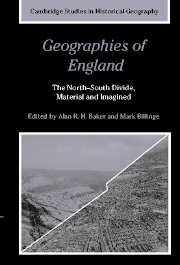Book contents
- Frontmatter
- Contents
- List of figures
- List of tables
- List of contributors
- Preface
- 1 Material and imagined geographies of England
- 2 The contemporary debate over the North–South divide: images and realities of regional inequality in late-twentieth-century Britain
- 3 Distressed times and areas: poverty, polarisation and politics in England, 1918–1971
- 4 Industry and identity: the North–South divide and the geography of belonging, 1830–1918
- 5 Divided by a common language: North and South, 1750–1830
- 6 South, North and nation: regional differences and consciousness in an integrating realm, 1550–1750
- 7 North–South dichotomies, 1066–1550
- 8 Cultural constructions of England's geography and history
- References
- Index
- Cambridge Studies in Historical Geography
3 - Distressed times and areas: poverty, polarisation and politics in England, 1918–1971
Published online by Cambridge University Press: 10 December 2009
- Frontmatter
- Contents
- List of figures
- List of tables
- List of contributors
- Preface
- 1 Material and imagined geographies of England
- 2 The contemporary debate over the North–South divide: images and realities of regional inequality in late-twentieth-century Britain
- 3 Distressed times and areas: poverty, polarisation and politics in England, 1918–1971
- 4 Industry and identity: the North–South divide and the geography of belonging, 1830–1918
- 5 Divided by a common language: North and South, 1750–1830
- 6 South, North and nation: regional differences and consciousness in an integrating realm, 1550–1750
- 7 North–South dichotomies, 1066–1550
- 8 Cultural constructions of England's geography and history
- References
- Index
- Cambridge Studies in Historical Geography
Summary
Introduction
It is now commonly understood that for most of the first half of the twentieth century England (and Wales) was socially divided along simple geographical lines to a degree that has not quite recurred since and to a degree that had not occurred so starkly before. The truth of this statement lies in the meaning of the terms. By socially divided I mean the variation in people's life chances. These chances range from a person's chance of being ill and dying, to finding work, to the kind of work they do. It does not take a great leap of imagination to assume that if such fundamental chances as these were strongly polarised then much else that is much harder to measure was also starkly polarised during most of this period – ranging, for example, from the distribution of wealth, to opportunities for recreation and education. By ‘along simple geographical lines’ I mean very simple – in fact involving simply one line: the line that divided the North from the South. There have always been geographical divides – between streets within cities, between town and country and so forth – but I would argue that there has not been, at least since this period, such a simple line to be drawn across the map of England. The North–South divide is still very much apparent today, but it is now more an echo, and perhaps largely a product of the divide which grew so great in these years.
- Type
- Chapter
- Information
- Geographies of EnglandThe North-South Divide, Material and Imagined, pp. 44 - 63Publisher: Cambridge University PressPrint publication year: 2004
- 4
- Cited by



